How to Part Out LEGO Sets: Sorting Your Way Out of a Dark Age
/Today’s article comes from Katie Walker, who has contributed to BrickNerd before with articles about her cheese slope mosaics. Today, she shares a very personal story about sorting LEGO… and cats.
LEGO Sorting and Cats
Hello! My name is Katie, and I have a LEGO sorting problem. Or perhaps it’s more like a hobby? Either way, my method may not be to everyone’s taste, but it works for me. I had an active building streak when my oldest kids were little (lots of cheese slope mosaics, etc.), but then I went back to work and entered a gray age—a time when an AFOL stops building because of time, interest, or just life getting in the way. I kept buying sets and building them, then dismantling and sorting them.
Then I had another baby and moved to a bigger house. Somehow, I now have less space for building. I have a desk in the room with the LEGO, but I really prefer something larger, like the kitchen table. Our previous table was somewhat small, so when it gave out, I insisted on the longest table that would fit in our space—at least now I can push all the LEGO to the end when we’re eating dinner (and hope that the cats and the kids don’t mess with it… FYI, cats love LEGO. I should start buying them some for their birthdays.)
This was the state of my collection before I started working on this article:
We just converted a front room into a bedroom and moved a bunch of things around and it’s not all settled yet.
So come along with me as I take you through my sorting process and then as I part out a few sets into my collection. I sort everything visually so I know what I have just by looking at it, and most sets eventually get parted out into their basic bricks so I can build with them in the future. Oh, and keep an eye out for my cat who will cameo throughout!
My General Organizational Principles
Know where everything is without having to look
Everything needs to be strictly labeled. If there is more than one container with the same pieces, the containers should be labeled as “1 of 3,” etc. Shelves should be organized as well. In the above photo, the left shelf holds primarily containers of bricks and plates, organized from most colorful on the top to dullest on the bottom. The shelf next to it is filled with elements sorted by type. In general, I keep my favorites at the top and the least favorites at the bottom. It helps me to know where to look! The last shelf is for larger containers full of chunky bricks, large plates, etc.
Make sure nothing gets hidden or lost
As part of knowing where everything is, I need to be able to open a case and see all of the contents. A random piece shouldn’t be hiding under a different style or color. How will I know it’s there? So, if pieces are combined in compartments, each element needs to be visible.
Combine colors evenly
If elements are going to be mixed, it’s best to get it as close to 50-50 (or other equal divisions) as possible. One red bar thingy amidst a hundred blue ones? I’d probably lose it. Fifty red and fifty blue? Great, I'll know they’re both there. A bunch of colors all mixed together with only a few of each? Even if I can’t see every color at once, I will still know it’s a mix and I might find more colors if I dig a little.
Keep parts together that I use a lot
For instance, cheese slope mosaics use lots of cheese slopes, 1x1 plates/tiles/bricks, and large tiles to form a bottom layer. This is one reason why 1x8 tiles are kept separate from the rest of the tiles. I can grab them all at once to use as a frame for the mosaic. (Also, they’re too long to fit in most of my container compartments with the other tiles. So, win-win!)
Have a mental category for every piece
There are just so many different kinds of pieces! If I can’t classify them in my head, I won’t know where to store them or where to look for them. And since I don’t have the BrickLink catalog memorized, it’s best to make up my own categories, even if it’s just something like strange accessories, long accessories, holes, tiny pins, memorabilia, etc.
Keep it all portable
I almost never build where my collection is stored. I carry everything around the house, usually to the kitchen. I’ve been known to port a boxful or two to my mother’s house. So, I try to keep only the useful pieces in as few containers as possible.
Take up as little space as possible
This is partially to keep my husband happy. He’s not a fan of LEGO spreading through the house. Also, with three kids, I don’t have as much room as I used to. So, to take up less space, I stack bricks. I try to fill containers evenly and fully. I try to acquire the perfect size of containers (which comes out of the LEGO budget).
Stack everything stackable in a way that is easily undone
Stacking helps take up less space and makes it much easier to access the pieces I need. But some pieces (like plates) need to be stacked in certain ways (e.g. by offsetting them) so as to facilitate unstacking them. Though amazing, I don’t love brick separators enough to want to use them just trying to access my bricks.
Realize that sorting LEGO is a losing proposition
I’ll never get it perfect. I’ll never even truly finish. I usually get about 85% of the way done and decide it’s good enough. And if, for some reason, I desperately need a piece that I can’t find in the sorted bricks, I’ll know that I can look in the sorting shoe boxes. I get them empty enough that it would be easy to just glance in and see if that piece is there or not.
My Sorting Process
My sorting process usually follows the same pattern every time:
Dismantle and stack.
Pull out large and obnoxious pieces.
Sort by color.
Put away everything that is sorted by color.
Sort the remainder by part.
Put away pieces by part.
Get sick of it and stop till next time.
There is often a lot of overlap in these steps, and for the remainder of this article, I will elaborate on this sorting process.
1. Dismantle and Stack
A sorting spree usually happens after I have a few new sets built up that I don’t have shelf space for anymore. I had a couple that needed to be sorted before writing this, but I took the opportunity to go buy another because who wouldn’t use any excuse to buy more LEGO? Besides, that art school was $15 off. How could I refuse?
So I drag all these sets down the stairs to the kitchen table (both because of the space but also because it’s where the kids will be). For this article, I started with these sets: 41711 Emma’s Art School, 10314 Dried Flowers and 10281 Bonsai Tree.
Oh hello, kid in the background
I usually dismantle one set at a time because each set has a limited number of different parts. That way, it’s easier to group them without throwing them in with the masses.
As I dismantle, I stack everything that I can. I can hear the wailing in the comments that this is a terrible, horrible, no good, very bad practice, that it will reduce the clutch power of the bricks, and that I am doomed or something. Perhaps. But I love the strategy so much that I don’t really care. It makes everything so much easier and neater, and I pretty much get an emotional high from stacking all those little pieces in neat and orderly rows. So far, I haven’t encountered any negative consequences from this process. And if in 20 years or so I suddenly find that my bricks won’t stick together… oh well? It’s not like cheese slope mosaics need a whole lot of clutch power anyway!)
Everything stackable gets stacked, including leaves, tiny round plates, and all the rest.
Oh look, I have a helper.
2. Pull Out Large and Obnoxious Pieces
I usually pull out all the random and large elements and set them aside. This includes minifigs, plates, doors, ladders, stairs, or whatever. I’ll dump these in a box or a bag to go through later. Sometimes, I’ll start pulling out specific parts such as slopes or Technic things (see Step 5) and start a box/bag for those, too. It depends on which elements are overwhelming the rest. I try to get the easy stuff out of the way to make sorting everything else easier.
3. Sort By Color
After stacking for a while, I raid the kitchen cupboards for plastic containers and start dumping each color into a different one. I have bought a lot of my own plastic containers, and yet I still resort to stealing from the kitchen. (Every. Single. Time. And then the pieces overflow and I remember I have cheap, nifty shoe boxes from Walmart to hold them in. Every. Single. Time.) We’ll get to those shoeboxes later.
Depending on the amount of what’s present, certain colors will be combined like all the strange greens or variations of blue. It’s not that I’ll actually store all of these things by color, but I need a temporary place for them to go. This is especially true for the unstackable pieces because they are annoying little things that like to explode into full-on chaos at any opportunity. Furthermore, in a given set, it’s likely that many of the parts only come in one or two colors, and sorting by color yields similar results to sorting by part.
Some of those kitchen containers at work
Once the first set I dismantled is sorted by color, I think to myself, “Should I go get the permanent storage containers and put these bits away? Or should I dismantle the next set and combine those pieces with the first set? Then, I won’t have to put away some of the same elements twice.”
It’s always a debate about which way would be more efficient. That art school set has leaves. The dried flower set also has leaves. Wouldn’t it be better to combine them and then put away all the leaves at the same time? But watch out. Combining pieces from too many different sets into the color containers makes sorting by color less useful as a means of separating parts. The more sets involved, the more variety each color bin will have, and that slows down the sorting process later on.
In the end, I seem to always decide to dismantle all the sets before putting them into their final resting places. (Considering that many of these pieces will probably never be used again… It is a bit like laying them to rest.) This decision is mostly made because it’s easier and more fun to dismantle and stack the next set to be parted out rather than putting everything away. Dismantling and stacking feel like you are making actual progress. The rest of the process is so slow it is kind of dispiriting.
Yes, I can hear you wondering why I would continue on with such a hopeless endeavor. And the answer is that my brain needs everything just so, or it’s Not Happy. This is one reason I would say that sorting is a hobby in itself. Yes, it contributes to more easily building stuff later, assuming I get around to it again. But more important is the feeling of satisfaction of a job well organized.
4. Put Away Everything Stored By Color
These are the things that I store by color:
Bricks.
Plates (except 1x1).
“Small Special” things which include tiles (except 1x1, 1x8, or anything wider than two studs) and a few other small things, such as jumper plates.
Ideally each color would have one container for bricks and one for plates and everything would fit perfectly. But since quantities of each color differ, there will be variations such as combining bricks and plates together into one case, combining multiple colors together, putting different sizes in the same compartment, or keeping shorter bricks/plates in one case and longer ones in another.
At some point in the sorting process the kitchen containers overflow, and I transfer the colors to the Walmart “shoe boxes” (that’s what Walmart sells them as). They’re a dollar each, which is more budget-friendly than most of these containers. (I really need to use them more for final storage purposes, but it’s so hard to get away from the addicting precision of the smaller containers.)
Here’s an example of how I sort by color, using black pieces. I’ll dump all the black onto the table, stick the shoe box in my lap, and then sweep into the box anything that I’m not sorting for. Normally, I’d probably be sorting for bricks, plates, and tiles at the same time, but in these photos, I’m just sorting for tiles and other “small special” pieces.
So then I have all the small special, and they need to fit into this case. But I decide that this case doesn’t have enough compartments for all the different elements, so…
… I dump it all out and move it into the larger case on the left. It feels so good to get everything into its perfect place.
That’s better! Here is how the black tiles, plates, longer plates (2x6 to 2x16) and bricks ended up:
So pretty! However, those 1x10 bricks have to share a compartment with those ridgy 1x2s. Oh well. I can still tell what’s under the 1x10s, so nothing will be lost. The other colors are all stored similarly, though for rarer colors, multiple will be combined into one case.
5. Sorting by Part & 6. Putting Them Away
At some point in the dismantling process (sometimes before color sorting is done), I realize I have enough of a certain kind of piece that it would be beneficial to actually put it away (or at least syphon it off into a holding bin.) For instance in this sorting session, I acquired a lot of 1x1 Dots. So it’s time to run up the stairs and get the cases that contain my current Dots collection.
As I try to put the pieces away, I realize these particular cases are a nightmare. The little walls between each compartment fall out at the slightest provocation, mixing the contents. Also, the bottoms of the compartments are not rounded, so when I need to fix a compartment wall malfunction or move a type of tile to another compartment entirely, it’s almost impossible to remove more than one piece at a time. I kind of have to pluck them out, and good luck getting more than one or two in one go! I’ve tried using spoons and various other implements of destruction, but nothing has been very helpful.
So I run upstairs and look for an empty case. I have one, but when I dump in the Dots, I decide it’s not good enough. Look at all that color mixing. So not pretty!
I have rules about mixing colors. Generally, it’s best to mix colors that don’t look the same. And it’s best to mix colors that you have in similar amounts so that I can just look and tell how much I have. If I mix a color with 500 pieces with a color that only has 20, most of the 20 will potentially be hidden. I’m afraid I won't remember that I have a certain piece because it’s hiding under something else.
Furthermore, having more than two colors in one compartment drives me mad. Ideally, every color and piece would have its own spot, though that isn’t always practical. I really wanted some of my larger cases with unmovable walls for these Dots. These were more expensive than the dumb ones with their flimsy walls and flat bottoms. But they are great! The sides don’t fall out when removing pieces, and the rounded bottoms help me pull out any number of pieces in one go.
But when I checked, alas, all those desired containers were already in use. So, it’s time to take another trip upstairs to the shelves and see which one should be reassigned. There are a couple of options, but the winner was this box of hats.
Once upon a time, I had enough hats that I could organize them like this. But no longer. Now they all get thrown in the minifig drawer. So out these go too. Now they’re in a random plastic box upstairs. They should probably be dumped in with the minifigs, but… there are non-hat/ hair things here. If I dump them in, they might get lost forever…
This is where I dream about building up tiny shelves to display every single minifig I own and then going back through 40 years of accumulations and matching each one to its original accessories by going back and looking through all the instruction books. Wouldn’t that be nice? But even I realize that’s a pointless task.
So I start moving all the Dots into the nice container… but then a cat comes along and steps on the lid, which jolts the whole thing, and then we have this new mess…
She looks so sweet and innocent, doesn’t she? “Who me? Cause problems? I would never! Now be a good girl and rub my belly.” With all that fluff, how can I resist?
After a bit more time soring, I finally finished with the Dots. I cleared out another one of those ideal containers and now have one for circles and one for quarter-circles and U’s (aka tooth tiles). The mixing of colors isn’t too terrible. I’m content. Great, I finished the Dots. Only hundreds more pieces to go!
In general, specific parts (e.g., slopes, brackets, or whatever) get sorted into some large kitchen containers I bought for this purpose. Each gets one category of part, and then they all get stacked up. Then eventually they’ll get put away in their proper places.
Here is some of that sorting of parts mid-process. Different tubs contain clips, arches, pieces with axle-cross holes, Technic holes, slopes, windows/doors/panels, etc.
Here are some photos of how these other pieces get stored.
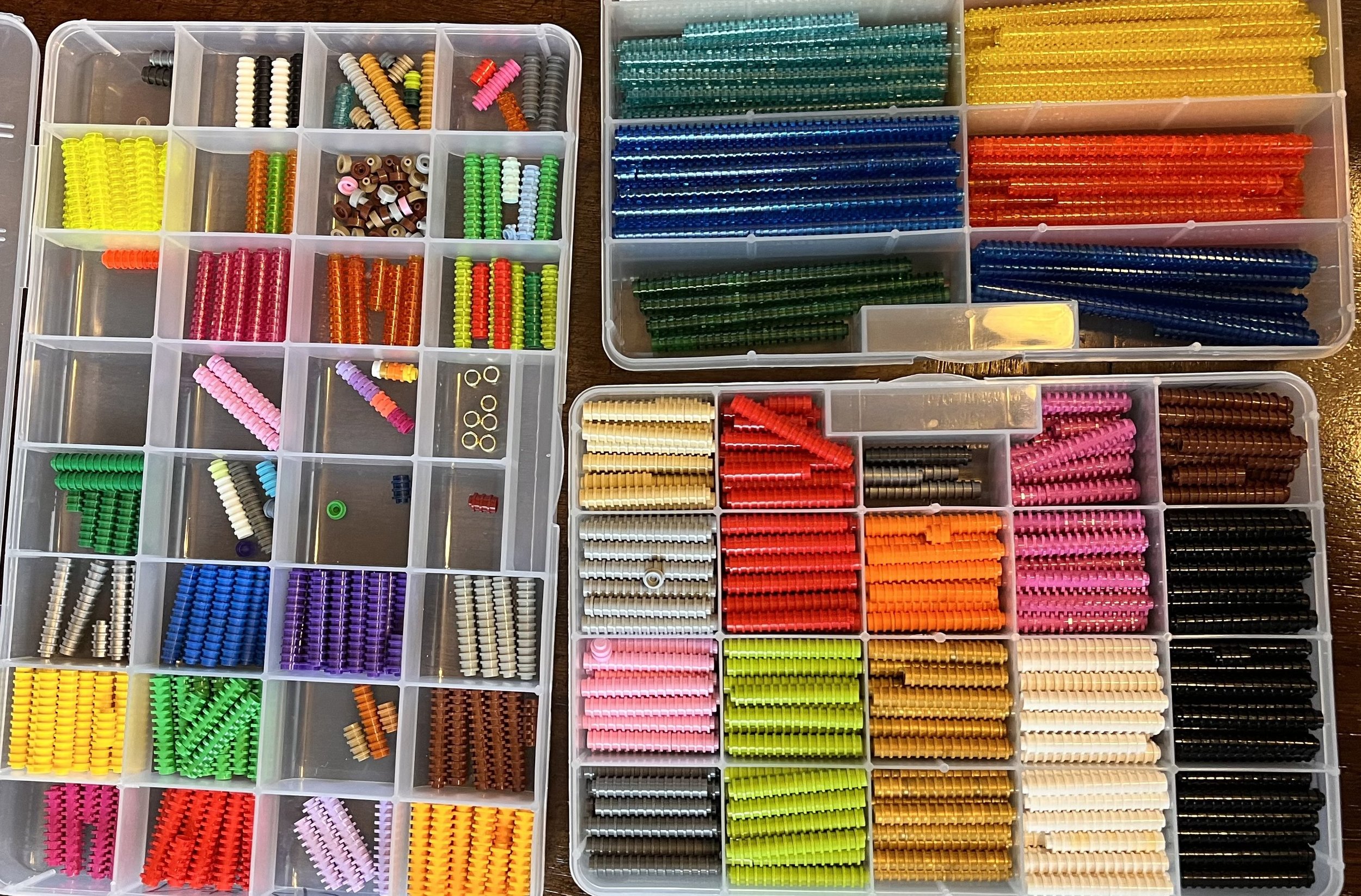
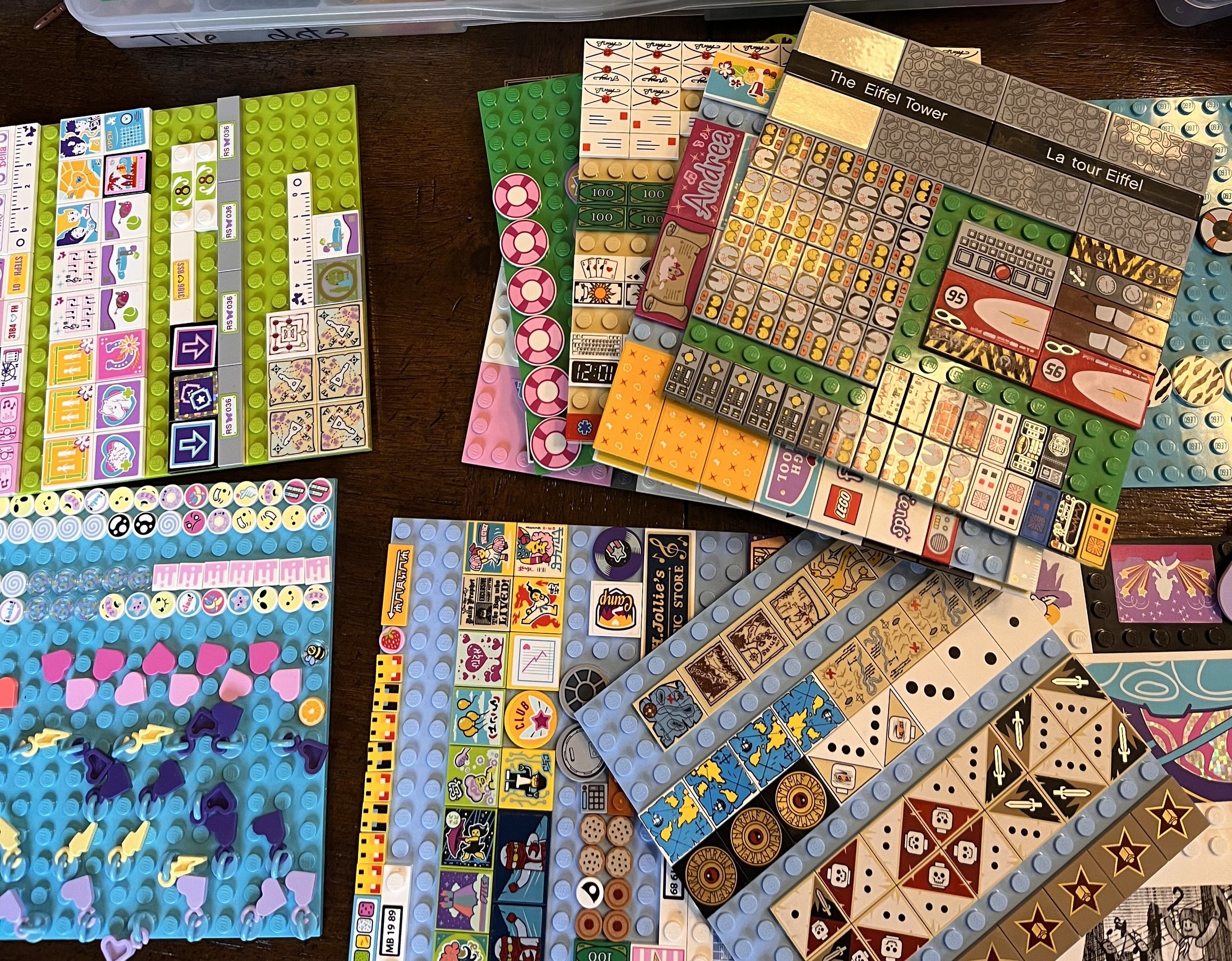

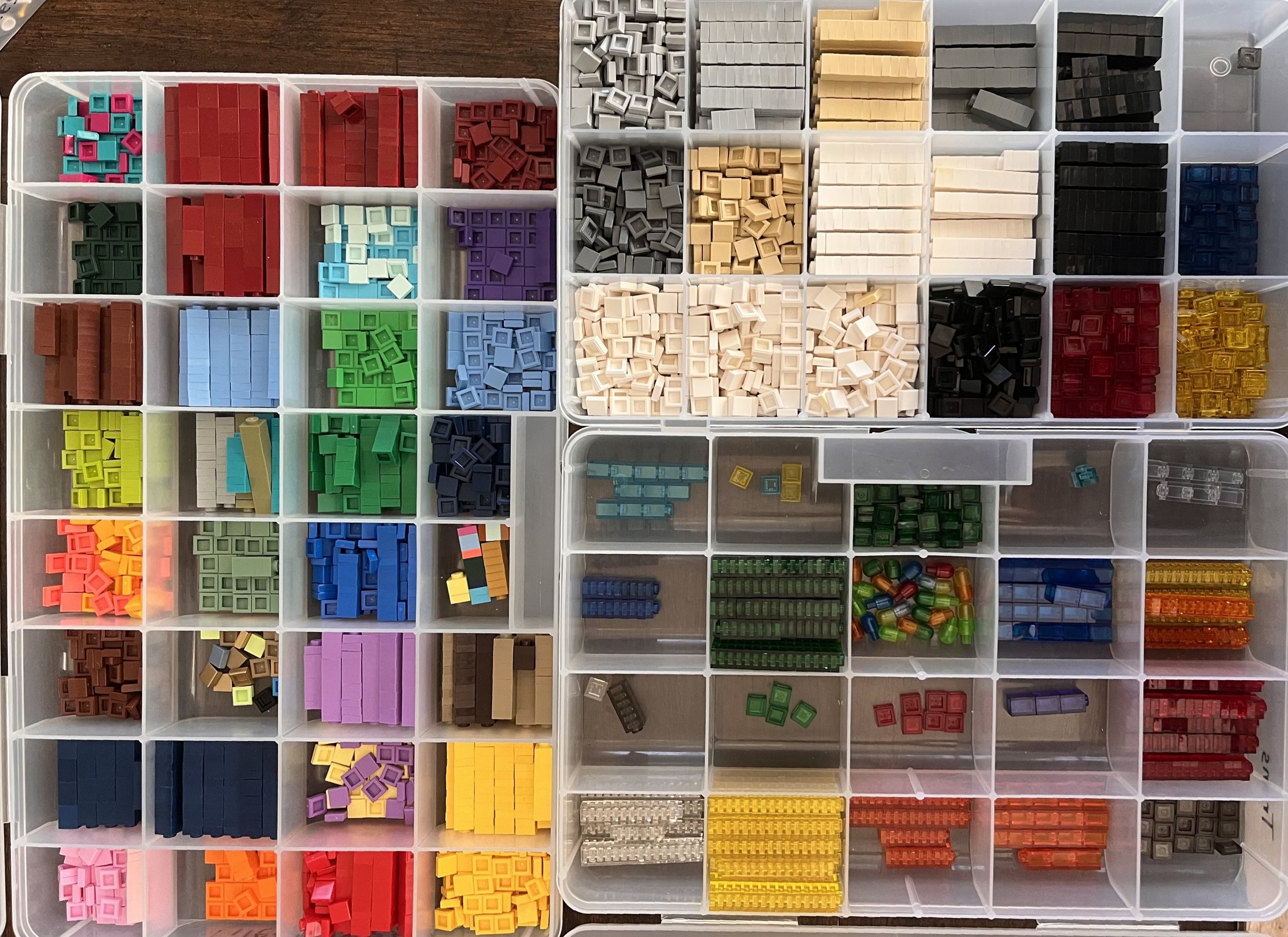
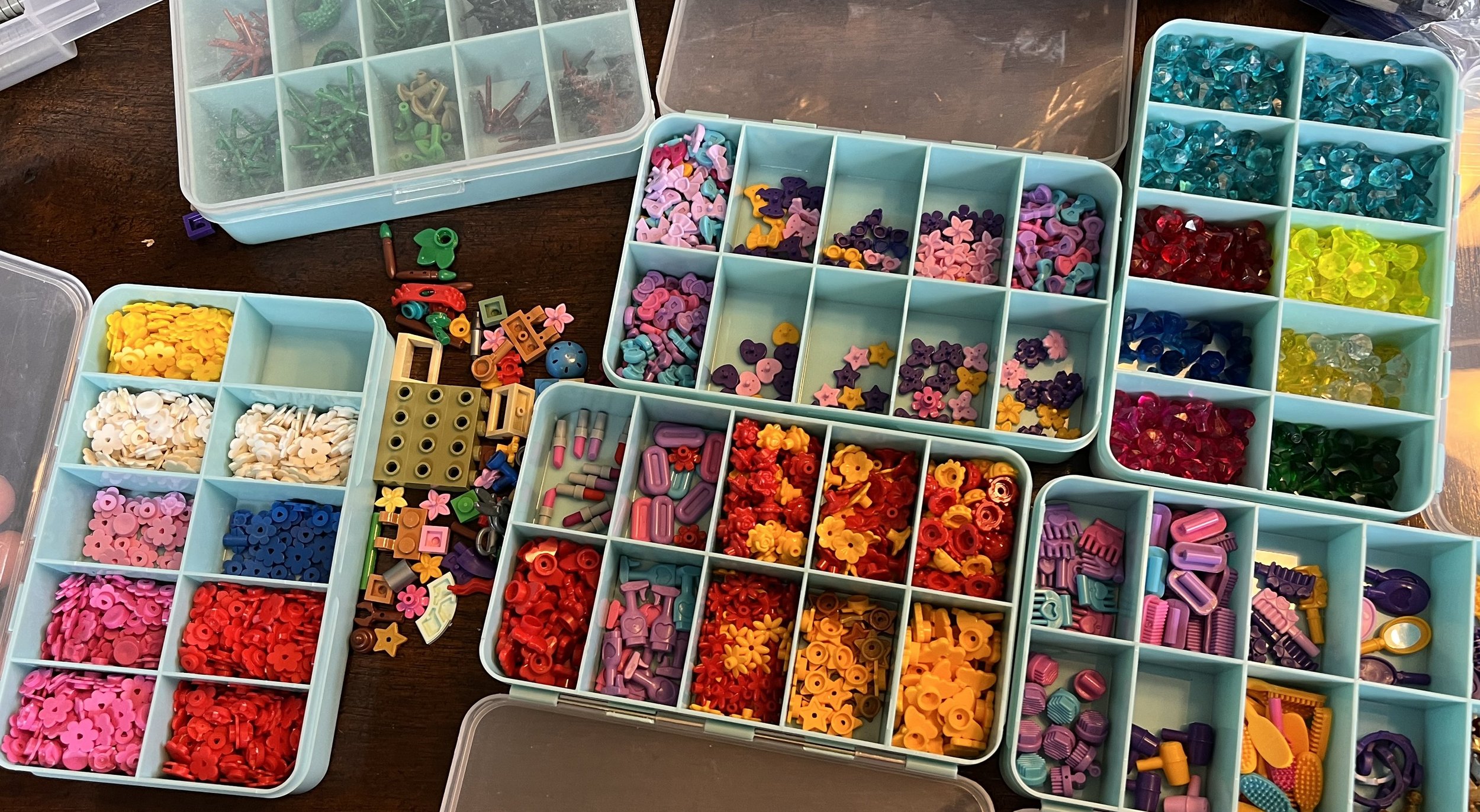

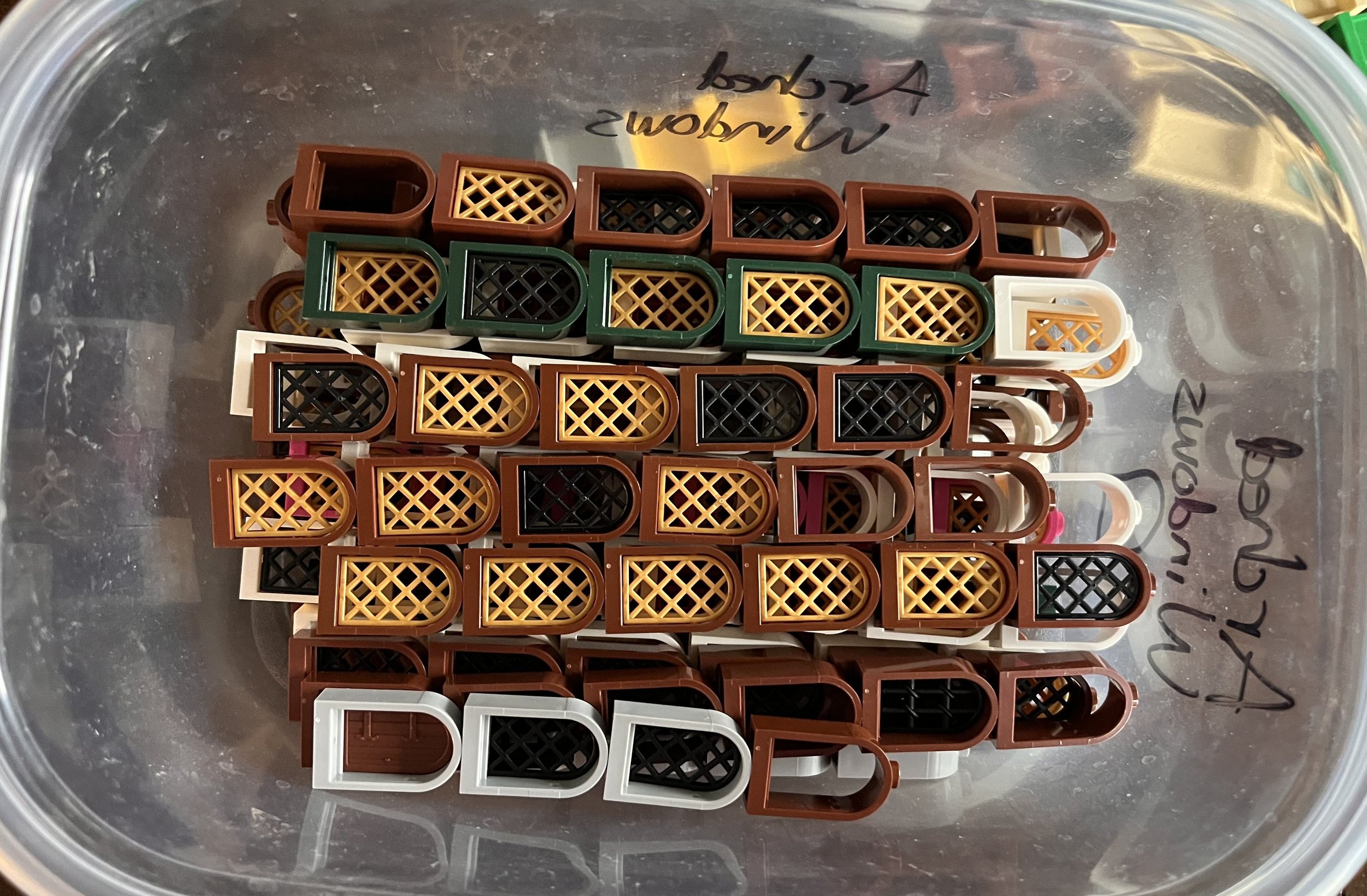

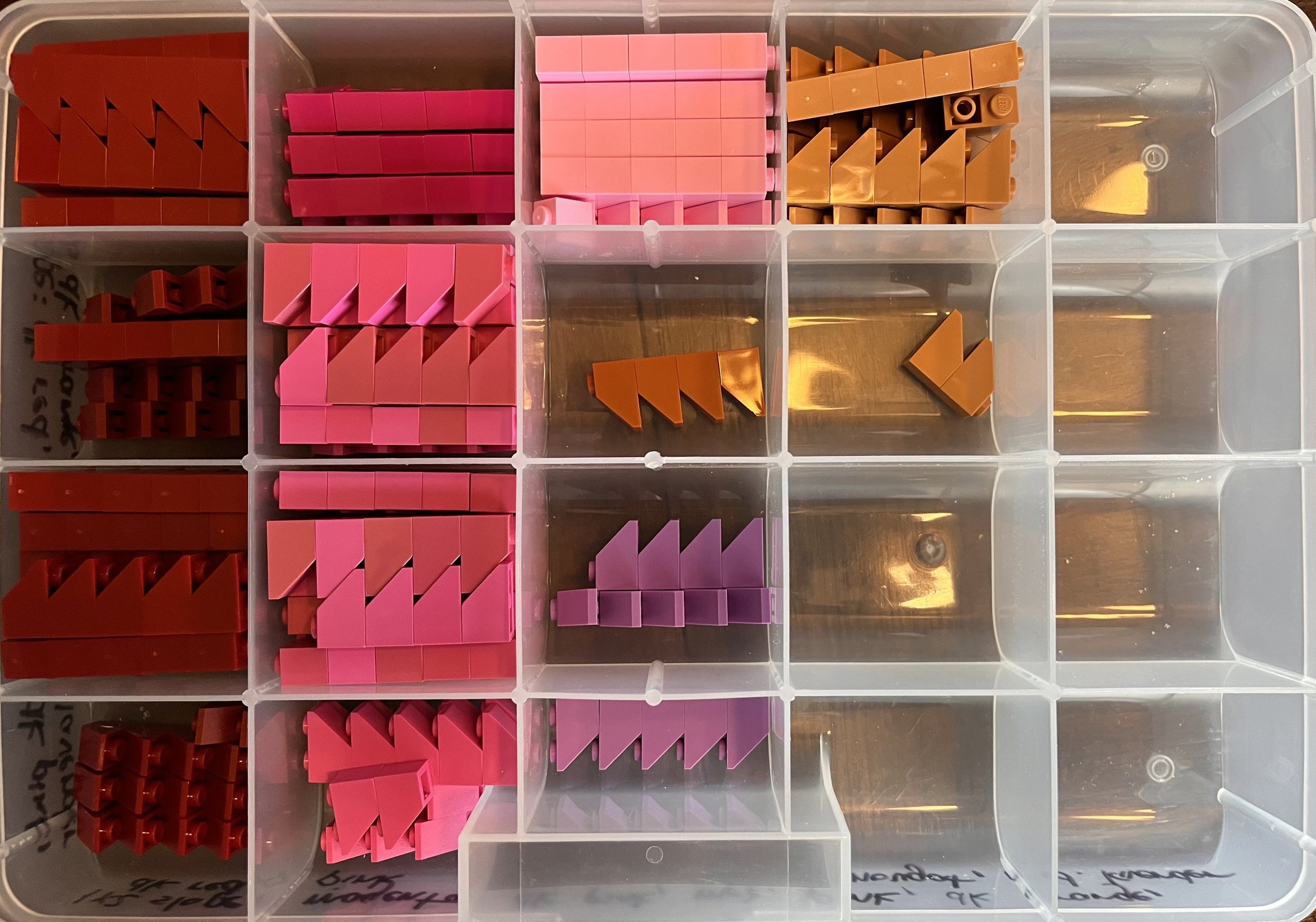
This next photo was taken before the most recent sorting session. This is where I can start getting irritated at LEGO’s increasing creativity. I have ice cream cones here, but now I have many others from sets where they aren't used as ice cream cones anymore. So I’m starting a new case of some of these elements that I think of as “new”—as in ones I didn’t have (or have many of) until the last few years.
Kitchen supplies
The goal is for me not to lose anything. Where would I think of looking for those ice cream cone pieces? Do I still even label them ice cream cones? That implies a limited use for them—only for serving ice cream—and just the act of calling them “ice cream cones” might limit my memory of having a piece that can be used for other things. I have a similar problem with the sausages. I have acquired a whole bunch of black sausages in a recent set I bought (not pictured). And they aren’t used as sausages in that set. They don’t qualify as solely food anymore. Should they stay with the sausages that actually look like food?
Image via BrickNerd
I guess I’m trying to find a way to store parts so that I’ll be open to creative uses for different pieces. Like those white forks in the silverware bin that were used to hold petals in the orchid set. Yes, they’re forks. But if I store them in the kitchen case, will I forget that they could be used for other things? I do go looking through cases to see if I can find pieces that can be used for something other than their original purpose. But once you get to a certain amount of LEGO, and it’s hard to look through all of it.
For example, here is green clown hair that LEGO has decided to use as a bush. Brilliant! But do I store it with minifig hair or with plants? I’m choosing plants because I really can’t imagine needing green clown hair ever—it’s much more likely I’ll want a bush. Ideally, I’d have some sort of complete electronic record of my collection with cross-referencing so that parts would show up in multiple categories. I can dream.
7. Get Sick of It and Stop Until the Next Time
Sorting is a hobby. Of course LEGO needs to be sorted to be useful, but it doesn’t need to be sorted to the point of insanity. So when I stop enjoying sorting—when I feel ill just thinking about it— I’ll stop. I like to say it’s usually about 85% of the way done, but it could just as easily be at 70% or 95% completion, depending on the day. At a certain point, it becomes thankless.
Perhaps I find one tiny plate somewhere, but I’ve already put those away. Do I make the effort to go get the case and put it in? Or just wait till the next time I have sets to sort and add it in with the new stuff? It is usually easier to wait. And at least I know it’s in the sorting bins and easy enough to find should I need it.
So that’s the general overview of how I sort LEGO until I change my mind and resort my collection again… unless you want to hear about my DUPLO collection…
Best of BrickNerd - Article originally published May 23, 2024.
How do you part out sets and sort your bricks? Let us know in the comments!
Do you want to help BrickNerd continue publishing articles like this one? Become a top patron like Marc & Liz Puleo, Paige Mueller, Rob Klingberg from Brickstuff, John & Joshua Hanlon from Beyond the Brick, Megan Lum, Andy Price, Lukas Kurth from StoneWars, Wayne Tyler, Dan Church, and Roxanne Baxter to show your support, get early access, exclusive swag and more.







































